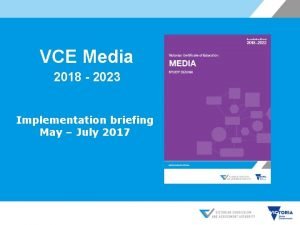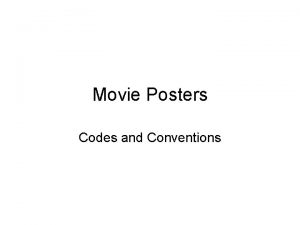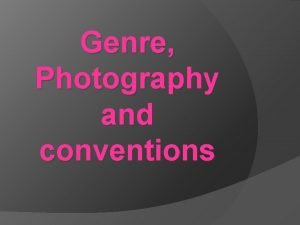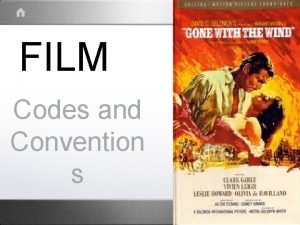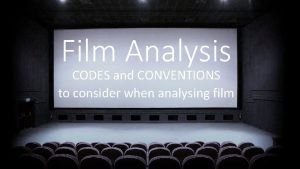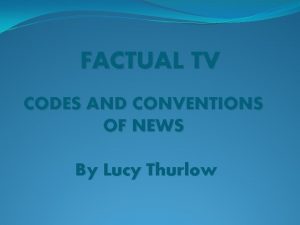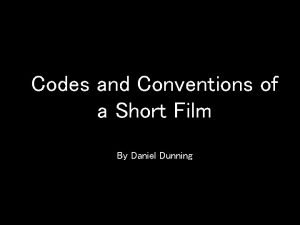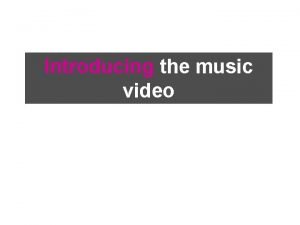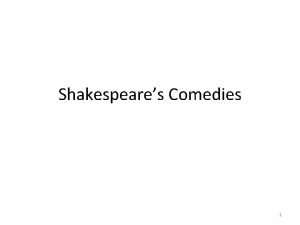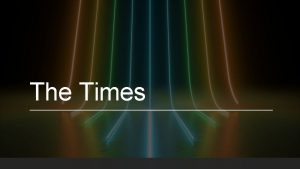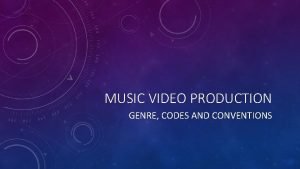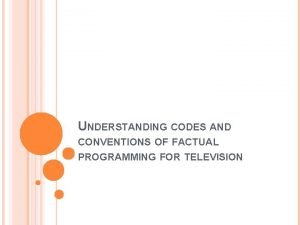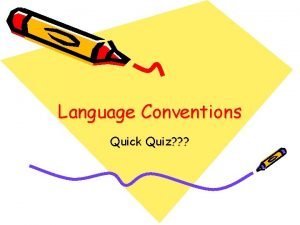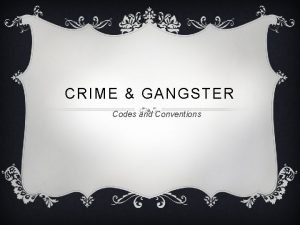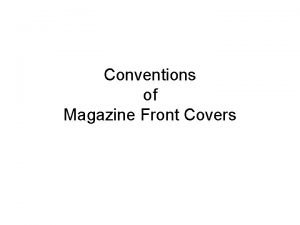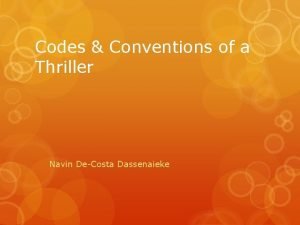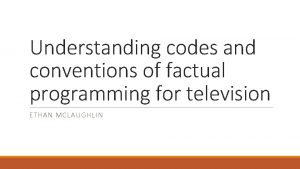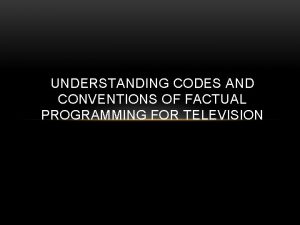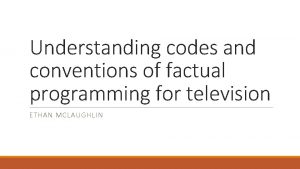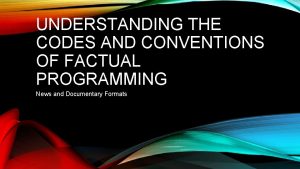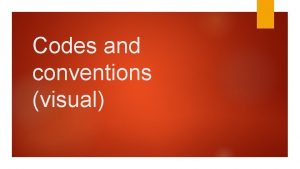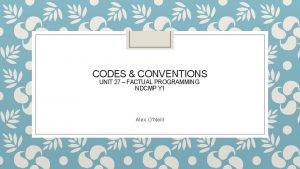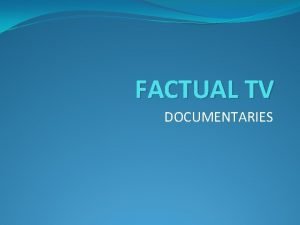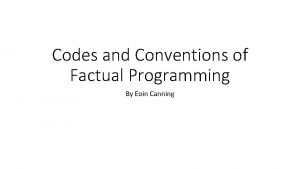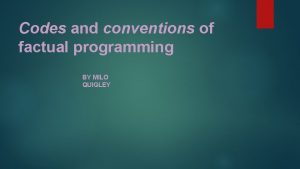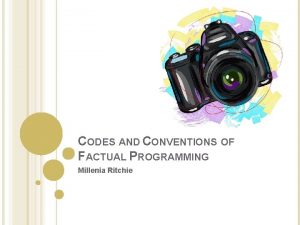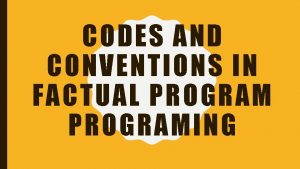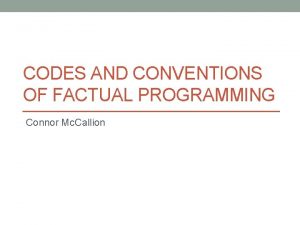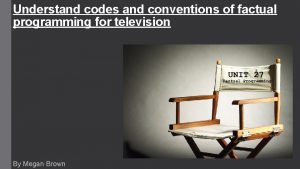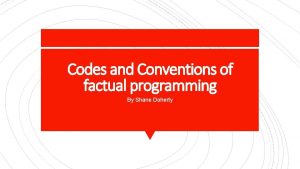Unit 27 Understanding Codes and Conventions for Factual



















- Slides: 19

Unit 27: Understanding Codes and Conventions for Factual Programing By Aisling Sweeney and Caoimhe Mc. Laughlin ND. YR 2 Jim Doherty

Codes and Convections of TV News Programmes

Studio Newsreaders A news presenter (also known as newsreader, anchorman or anchorwomen) is a person who presents news during a news program in the format of a television show on radio or the Internet. Newsreaders provide the latest news to the public, interview people who have information/ their own personal opinion to share about a certain story/topic. Also, research topics and stories from worldwide to inform people about news that is happening that current day. An example of a newsreader would be Bryan Dobson who presents RTE News. https: //www. youtube. com/watch? v=w. B 2 p. EPk. EH 2 U

Field Reporters A correspondent or on the scene reporter is a journalist or commentator, or more general speaking, an agent who contributes reports to a newspaper or radio or television news from a remote often distant location. They are stationed in a foreign company, the benefit of this that viewers can get a clear of image of what’s happening at the time and that place. They capture more-in depth news as it’s taking place, but essentially they don’t have to be formally dressed but have to look professional on the job. An example on a Field reporter would be John Ray who presents field reports for ITV News. https: //www. youtube. com/watch? v=kr. ZW 6 Ivd. KOc

Links to Studio This is where televised news show links with another studio by satellite connection. This can often be found on mainstream news channels such as the BBC and ITV and also on some American news channels. It’s important other TV studios link to each other as it can give more curtail information/detail needed to a story and that the newspresenter can interview another news-presenter without leaving their TV studio/location. An Example – Jessica Yellin recorded as a hologram for CNN news report on the American election. https: //www. youtube. com/watch? v=th. Ox. W 19 vs Tg

Mode of Address to Viewer This is how the reporter delivers the news to the viewers of listeners. It can be done in first person, this is when you speak about yourself, and 3 rd person is when you can use narrative. News reporters will usually open the show by saying “good morning” or “good evening” depending on time of day. Also by using different words such as “you” can be a direct mode of address involving the viewers and also keeping a good eye contact into the camera. Example: the BBC and ITV are a serious, informative news channel, targeted to an older target audience. To make this clear the presenters will be serious and dressed in a suit to show that this is serious and factual – not a laughing matter. As for Mock of the week, it’s very colourful and they all dress like usual every day looking men and are smiling and laughing throughout which tells the audience that they can laugh despite the serious and controversial subjects that often make conversation. It’s all about making it clear to the audience, Also the Channel 5 news is less formal with more slang words used that connects with a younger audience.

Interviewing/Experts and Witnesses Interviewing is when someone is being asked questions relevant to a certain topic or view, this is to gage a better understanding of what’s happened or get an opinion. Anyone can be interviewed so long as it’s a popular topic or something that most people would want to know more about. This is done because it offers a more informative, informal approach to the news, and this also makes it more personal to the viewer. Eye witnesses are also be interviewed on what they’ve seen and give their side of the story. Whilst Experts are used often to balance the story so it does not appear bias and back up certain cases with professional observations that were taken into account. Example: Brian Dobson interviews Olli Rehn - EU Economics Commissioner (Expert) https: //www. youtube. com/watch? v=Jn 3 S 5 Zh 3 Vm 0

Report Structure A report structure are simply steps that the programme follows whilst putting it across to the audience. It will often begin with the news-reader announcing the main headlines in the show (between 4/5) and refers back to the top story again with more in-depth information. This will start of with the headline name and then an introduction explaining the story to the audience. Then the reporter will usually cross over to a correspondent or an eye witness/ expert. Factual Programmes will go into cutaways and visual effects with a correspondents voice-over playing. The main body of the report, provides the main information and is clear and precise with a narrative along side. Then the conclusion wraps the report up, it gives the audience a final sum of the subject the presenter has discussed.

Actuality Footage is footage that is live from a scene that the news channel broadcasts, It will show the affects of what happened after the event also. Actuality Footage is very common on most news broadcasting channels, as it gives the viewer a better knowledge of the story that has occurred. An example of this is when the 9/11 twin tower crash occurred as there is real footage of the plane crashing into the second tower. https: //www. youtube. com/watch? v=_u 9 kieq. Gpp. E

Codes and Conventions of Documentaries

Different Types of Documentary Formats There are 8 different types of documentary formats: 1. Expository 2. Observational 3. Participatory/ Interactive 4. Reflexive 5. Performative 6. Realism 7. Dramatization 8. Narrativisation

Expository documentaries expose someone’s life, and often has a narrator speaking directly to the audience. This type of documentary can include interviews, facts, narrators and footage. This type of Documentary often will expose a subject that not many people know properly about. The technique known as “Voice of God” is the commentator talking over any images/footage that is being viewed by the audience. These are usually biographical or historical events that they will speak about. They have more of an impact on audience as it gives mystery of the unknown of exposing a person/subject that is unknown to many people/public eye. An example of this is the Bruce Jenner Special with Dianne Swayer, where he exposes the truth about being transgender for more than 50 years and how it’s affected his life, him personally with relationships and family. http: //abcnews. go. com/2020/video/bruce-jenner-interview-diane-sawyer-woman-part 30572231

Observational An observational documentary is based around a certain person/people, that follows them constantly with a camera crew on what occurs in their every day lives. The most common film technique in these documentaries is hand held cameras are the cameramen can move around with person/subject. Commentators aren’t used as much in these types of documentaries as they would distract the audience from the footage in front of them. Observational documentaries gives the audience the true feelings and eye witness of the person/ subject that is being documented up close and personal. Also, no interviews are present and the subject pretends that they were not being filmed by a camera crew. An Example of Observational documentary is “I am Cait” where is takes the viewer through the challenges that Caitlyn Jenner faces through her transition whilst being in the public eye through out it all. https: //www. youtube. com/watch? v=s. KZCc. VKVHws

Participatory/Interactive A participatory/interactive documentary is when the film-maker tends to become the subject of the documentary. They actively engage with the situation they are documenting asking questions and sharing experiences. Also Achieve footage can be used in the making such as news footage and information of websites/newspaper articles. “The voice of God” is sometimes used in interactive documentaries by the documentary maker. Participatory documentaries engage the viewer more deeper into the subject as the documentarian is witnessing it first hand. And also give a good explanations/reasons of why a certain subject is being filmed. An example of an interactive documentary is “Life of Michael Jackson By Bashir” (2004) where Martin Bashir follows/interviews Jackson about his real life. https: //www. youtube. com/watch? v=Kl 0 uqobe. VDM

Reflexive This type of Documentary Format focuses entirely on the realism and quality of the product being made. The documentary makers show the content being filmed, and allowing the viewer to see the problems and issues that film makers have to address on a daily basis. Documentary making isn’t as easy as people think. Most documentaries of this type are barely edited and avoid special effects being used, this is to keep the realism and truth of the documentary. Expressive and dramatic music is used to increase the storyline and engage the viewer further. An example of this is Nick Broomfield’s “Driving me Crazy” as it shows clearly Nick Broomfield in front of the camera with his crew and most of the documentary itself is about film making and more the actual content. https: //www. youtube. com/watch? v=qa. YOE 4 On_KQ

Performative A performative documentary acknowledges the emotional and subjective aspects of documentary and presents ideas as a part of context having different meanings for different people and are often autobiographical in nature. An Example of performative is “Tongues United” Marlon Riggs' essay film Tongues United gives voice to communities of black gay men, presenting their cultures and perspectives on the world as they confront racism, homophobia, and social exclusion. It broke new artistic ground by mixing poetry (by Essex Hemphill and other artists), music, performance and Riggs' autobiographical revelations. https: //www. youtube. com/watch? v=t. Wu. PLx. MBj. M 8

Realism is where real action takes place, with no staged scenes or scripts, everything is natural. Real life documentaries often use the ‘realism’ of people and events because of the natural flow and behavior; of the events that have took place in the documentary or in a persons life. Often scripts are made once the filming has already taken place, by watching over the interviews etc and then deciding which is relevant and which isn’t. This is what makes Realism documentaries different from dramatic Realism.

Dramatization is where a script has been edited in order to make something more dramatic, i. e. the news, by them using more dramatic words like Breaking News, Abomination, Mass Murder etc. all of which make something more dramatic and will make the viewer listen harder. It builds up tension throughout the making of the documentary and can be over exaggerated.

Narrativisation Narrative/Narrativisation is used commonly in documentaries as it’s a successful way of getting a story across to a certain target audience. Taking something complicated and unstructured and giving it narrative and structure; an understandable meaning for everyone to make sense of. The narrator makes the events and situations easier to understand describe what is going on in depth to the audience. The downfall of this is that it can easily become boring depending how it is used through the production of the documentary.
 Vcaa english study design 2023
Vcaa english study design 2023 Rings movie poster codes and conventions
Rings movie poster codes and conventions Conventions of genre
Conventions of genre Technical codes
Technical codes Film codes and conventions
Film codes and conventions What codes and conventions are used by the tv networks
What codes and conventions are used by the tv networks What are media codes and conventions
What are media codes and conventions Typical codes and conventions of short films
Typical codes and conventions of short films Blog genre conventions
Blog genre conventions Comedy codes and conventions
Comedy codes and conventions Pop music conventions
Pop music conventions Codes and conventions of comedy
Codes and conventions of comedy Codes and conventions of newspapers
Codes and conventions of newspapers Music video codes and conventions
Music video codes and conventions Refelexive
Refelexive Media codes and conventions quiz
Media codes and conventions quiz Technical and symbolic codes film
Technical and symbolic codes film Magazine conventions
Magazine conventions Conventions of a thriller
Conventions of a thriller Michael gomersall
Michael gomersall
